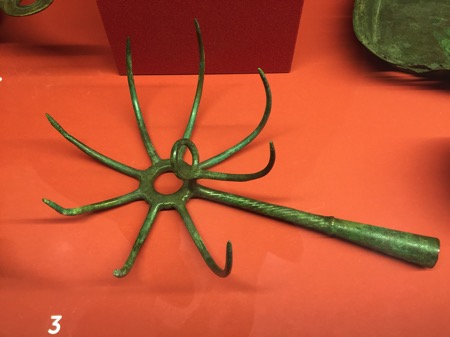I finally got to see the Feeding the Empire exhibit at the Ara Pacis in Rome on Saturday, and learned a lot about how Rome managed to keep a million people fed most of the time. In one of the display cases, I saw this astonishing implement.

It was labelled simply Harpago. No explanation, nothing. The word seems to be linked to harpoon, and is translated as “grappling iron” in some places. It also shows up “in insect morphology for the distal end of a genital clasper” and lends its name to spiny sea snails and a plant commonly known as Devil’s claw, Harpagophytum spp.
All of which makes perfect sense. But what on earth does it have to do with the preparation of food?
Meat hook
The link says “instrument of torture,” which I can well believe. How was it used as a meat hook? To pull meat from a fire? It clearly can be attached to a shaft or handle.
After entering “harpago” in Google image search and finding above info, nearest cuisinal association to flaying is clearly “meat”, so entered “harpago” + “meat” to Google, results amongst others:
Harpago (meat hook)
Cookery and Dining in Imperial Rome – Page 287 – Google Books Result
Joseph Dommers Vehling, Apicius – 2012 – Cooking
355 HARPAGO, a meat hook for taking boiled meat out of the pot, with five or more prongs; hence “harpoon.”
Wonders of the web, such fun!
Thanks. As you may gather, I’ve been a bit busy to Google for myself this morning.
It’s obviously a back scratcher.
Pullin’ Pasta from the Pot?
This is a torture artefact used by roman legion. The jewish tradition tells that Rabbi Akiva was tortured with it befor been burnt because he kept teaching Tora to his people.
It’s for dying wool or strips of cloth. It’s used to lift the wool from the dye. Then it is suspended by the ring in the center to allow the dye to drain back into the dye reservoir.
It can’t be used as a torture device because the claws are way too wimpy and the center ring would get in the way.